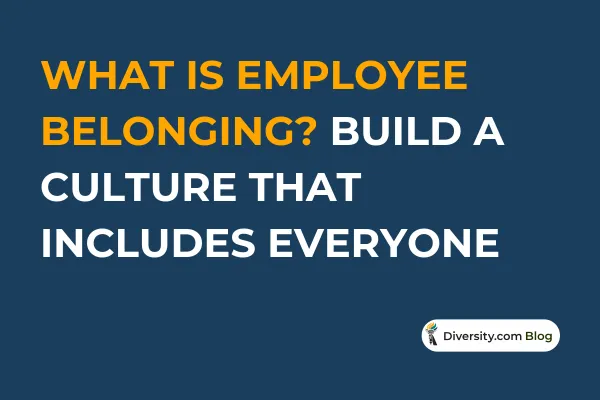
What Is Employee Belonging? Build a Culture That Includes Everyone
What Is Employee Belonging?
Employee belonging is the feeling of being accepted, valued, and supported at work.
It reflects emotional safety, cultural connection, and the freedom to show up authentically. When employees feel a genuine sense of belonging, they’re not just present, they’re engaged, motivated, and loyal (Qualtrics, 2022).
Unlike diversity or inclusion alone, belonging is deeply personal. It’s what transforms representation into connection, and policy into culture.
Quick Take: Why Belonging Matters
Increases employee engagement and innovation
Reduces turnover and burnout
Strengthens inclusive culture and retention
Signals psychological safety and inclusive leadership
Helps humanize workplace equity without politicizing it
Why Belonging at Work Matters More Than Labels
While DEI initiatives often focus on metrics, belonging is what employees actually feel day to day. And that emotional connection drives real business outcomes:
Belonging increases performance by up to 56%
Companies with strong belonging see 50% lower turnover risk
Employees who feel they belong are 3.5x more likely to contribute meaningfully
(BetterUp, 2019; Seramount, 2023)
In a political climate where “DEI” is increasingly misunderstood or misused, reframing around belonging at work is not just strategic—it’s safe. It centers human experience, not buzzwords.
How Psychological Safety Builds Belonging
Psychological safety, the belief that it’s safe to take interpersonal risks at work, is the foundation of belonging (Deloitte, 2020).
To build it:
Encourage open dialogue and dissenting opinions
Normalize vulnerability at leadership levels
Avoid penalizing honest mistakes
Establish team rituals that create space for voices from the margin
Ritual Ideas:
Rotate who leads weekly meetings
Open with “Who hasn’t spoken yet?” moments
Invite employees to share personal values or stories (opt-in only)
These rituals signal, again and again: you matter here.
5 Manager Behaviors That Build Belonging
Managers are the frontline architects of belonging. Here are five high-impact actions:
Give specific, personal recognition
Ask quieter voices for input proactively
Model vulnerability and growth mindset
Honor boundaries: cultural, emotional, personal
Act on feedback quickly and transparently
Even one inclusive manager can dramatically shift team dynamics (Gartner, 2022).
How to Measure and Sustain Belonging
Tracking belonging helps turn it from a fuzzy feeling into a tangible business asset.
What to measure:
Belonging index questions in engagement surveys
Promotion, attrition, and ERG participation data across identities
Psychological safety scores by team or manager
Exit interview themes related to inclusion or connection
Tip: Pair quantitative data with qualitative feedback—especially anonymous pulse check-ins. Employees involved in ERGs are 1.4× more likely to report high belonging (Perceptyx, 2024).
Belonging at Work: A Strategic Advantage
Organizations that cultivate employee belonging don’t just perform better: they endure longer. In a world where burnout, disengagement, and quiet quitting are rising, belonging is your moat.
It’s not political. It’s personal.
It’s not a trend. It’s a human need.
And it’s how you turn good teams into great cultures.
Frequently Asked Questions
What is employee belonging?
It’s the experience of feeling accepted, respected, and connected within a workplace. It involves psychological safety, inclusion, and shared culture (Qualtrics, 2022).
How do you improve belonging at work?
By building inclusive rituals, coaching managers, encouraging open dialogue, and tracking emotional experience, not just demographic stats.
Why is belonging important for companies?
Belonging improves engagement, reduces turnover, drives innovation, and builds brand loyalty (BetterUp, 2019; Deloitte, 2020).
How Diversity.com Supports Inclusive Hiring
At Diversity.com, we know that inclusive hiring isn’t about lowering standards—it’s about raising the bar and removing outdated filters that limit potential.
That’s why we equip employers with the tools, strategies, and talent pipelines to build teams that are qualified, diverse, and forward-thinking—without compromising on excellence.
Whether you're refining your recruitment process, improving retention, or navigating new DEI challenges, we’re here to support your mission with real solutions and real results.
For Employers & HR Professionals:
✔ Create a free employer account — Start posting jobs that reflect your values. Choose from single listings, job packs (discounted credit bundles), or subscription plans tailored to your hiring needs.
✔ Access a diverse, top-tier candidates — Connect with professionals who bring both qualifications and fresh perspectives to your team.
✔ Stay informed with expert DEI insights — Learn how to apply inclusive strategies without sacrificing performance.
For Job Seekers:
✔ Explore inclusive career opportunities — Discover employers that care about merit, culture, and impact.
✔ Create a free job seeker account — Apply confidently for jobs with companies that believe in equity.
✔ Understand Inclusive Hiring — Learn how DEI really works—and how it can work for you.
We don’t lower standards. We eliminate the barriers that keep talent hidden.
Start building a better, bolder team today—with Diversity.com.
Questions? Contact Us, and we'll walk you through it.
Related Articles
Workplace Representation Strategy: A Guide for Inclusive Talent Teams
Bias-Free Job Descriptions: Write Inclusive, Effective Listings
Unconscious Bias Training for Recruiters: What Works and Why
Merit-Based Hiring Practices: Balancing Fairness and Representation
Sources & References
BetterUp. (2019). The value of belonging at work: New insights on inclusion and performance. https://www.betterup.com/resources/blog/belonging-at-work
Deloitte. (2020). Creating a culture of belonging. https://www2.deloitte.com/us/en/insights/topics/talent/human-capital-trends/2020/creating-a-culture-of-belonging.html
Gartner. (2022). Psychological safety boosts team performance. https://www.gartner.com/en/articles/how-to-create-psychological-safety-on-your-team
Perceptyx. (2024). Are ERGs the key to workplace belonging?. https://blog.perceptyx.com/are-ergs-the-key-to-workplace-belonging-heres-what-the-data-says
Qualtrics. (2022). Belonging at work report. https://www.qualtrics.com/blog/belonging-at-work/
Seramount. (2023). Toolkit: Measuring belonging in the workplace. https://seramount.com/wp-content/uploads/2024/12/Toolkit_Measuring-Belonging-in-the-Workplace.pdf

